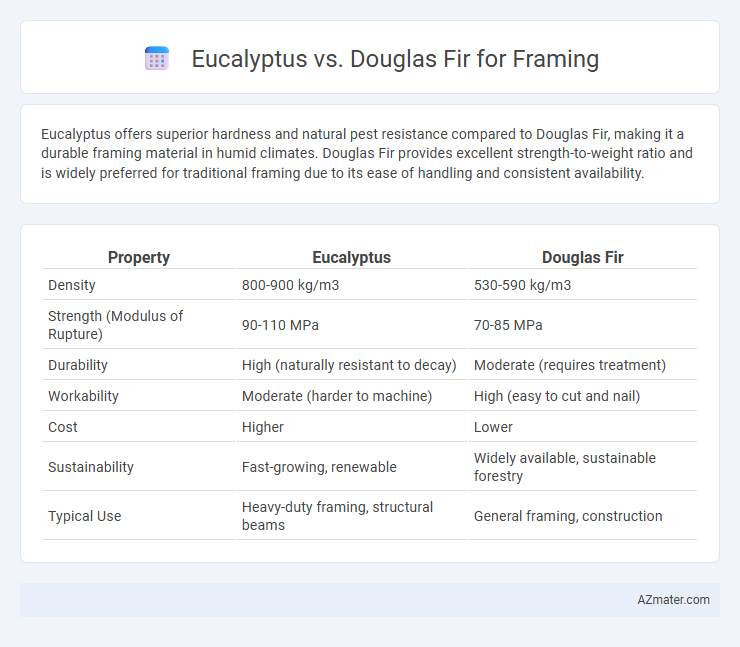Eucalyptus offers superior hardness and natural pest resistance compared to Douglas Fir, making it a durable framing material in humid climates. Douglas Fir provides excellent strength-to-weight ratio and is widely preferred for traditional framing due to its ease of handling and consistent availability.
Table of Comparison
| Property | Eucalyptus | Douglas Fir |
|---|---|---|
| Density | 800-900 kg/m3 | 530-590 kg/m3 |
| Strength (Modulus of Rupture) | 90-110 MPa | 70-85 MPa |
| Durability | High (naturally resistant to decay) | Moderate (requires treatment) |
| Workability | Moderate (harder to machine) | High (easy to cut and nail) |
| Cost | Higher | Lower |
| Sustainability | Fast-growing, renewable | Widely available, sustainable forestry |
| Typical Use | Heavy-duty framing, structural beams | General framing, construction |
Introduction: Eucalyptus vs Douglas Fir for Framing
Eucalyptus and Douglas Fir are two prominent wood species used in framing, each offering distinct advantages based on strength, durability, and availability. Douglas Fir is renowned for its high strength-to-weight ratio, making it a preferred choice in North American construction for load-bearing frameworks. Eucalyptus, commonly found in Australia, boasts dense, hard wood with natural resistance to pests and decay, presenting a robust alternative for framing applications requiring longevity and environmental resistance.
Wood Characteristics and Properties
Eucalyptus exhibits high density and natural durability, making it resistant to decay and suitable for structural framing in challenging environments, while Douglas Fir offers excellent strength-to-weight ratio and dimensional stability, ideal for standard framing applications. The hardness of Eucalyptus often results in increased wear on tools, but its resistance to pests and moisture is superior to Douglas Fir's moderate decay resistance and susceptibility to insect attacks. Both woods have favorable mechanical properties, yet Eucalyptus's greater density (approximately 750-1100 kg/m3) contrasts with Douglas Fir's lighter density (around 530-600 kg/m3), influencing their handling and performance in construction.
Strength and Structural Performance
Eucalyptus offers higher density and superior compressive strength compared to Douglas Fir, making it exceptionally durable for framing applications requiring robust load-bearing capacity. Douglas Fir is favored for its excellent strength-to-weight ratio and dimensional stability, providing reliable structural performance in various construction environments. Both species deliver strong framing solutions, but Eucalyptus's hardness and resistance to wear make it ideal for heavy-duty structural uses, while Douglas Fir remains a versatile choice due to its balanced strength and ease of handling.
Durability and Longevity
Eucalyptus wood offers exceptional durability and resistance to decay, making it a strong candidate for framing in environments prone to moisture and pests. Douglas Fir is renowned for its strength-to-weight ratio and natural durability, providing long-lasting structural support in standard residential and commercial framing. Both species exhibit excellent longevity, but Eucalyptus often outperforms Douglas Fir in terms of resistance to fungal attacks and termite infestation.
Resistance to Pests and Decay
Eucalyptus wood exhibits high natural resistance to pests and decay due to its dense grain and natural oils, making it a durable choice for framing in outdoor or moisture-prone environments. Douglas Fir, while strong and widely used in construction, is more susceptible to insect infestations and rot unless properly treated with preservatives. For framing requiring longevity in damp or termite-prone areas, Eucalyptus offers superior resistance, reducing maintenance and replacement costs.
Workability and Ease of Use
Eucalyptus wood tends to be harder and denser than Douglas Fir, making it more challenging to saw and nail but providing excellent strength for framing applications. Douglas Fir is prized for its superior workability due to its straight grain and softer texture, allowing easier cutting, nailing, and fastening during construction. The ease of use with Douglas Fir often results in faster project completion and reduced tool wear compared to the tougher eucalyptus hardwood.
Sustainability and Environmental Impact
Eucalyptus grows faster than Douglas Fir, making it a more sustainable option by enabling quicker forest regeneration and reducing deforestation pressure. Douglas Fir, with its strong carbon sequestration capacity, offers long-term environmental benefits by storing more carbon over its lifespan. Both woods have low formaldehyde emissions when used in untreated framing, but Eucalyptus often requires less chemical treatment due to its natural resistance to pests, enhancing its eco-friendliness.
Cost Comparison and Availability
Eucalyptus offers a cost-effective alternative to Douglas Fir for framing, typically priced 20-30% lower due to its rapid growth and abundant supply in regions like Australia and parts of the U.S. Douglas Fir, known for its structural strength, commands higher prices driven by demand in North America and limited sustainable logging quotas. Availability of Eucalyptus is expanding globally through plantation forestry, while Douglas Fir remains widely accessible but subject to regional harvesting restrictions affecting overall market supply.
Regional Suitability and Sourcing
Eucalyptus wood thrives in warm, temperate regions such as Australia, South America, and parts of Africa, offering fast growth and sustainable sourcing advantages for local framing projects. Douglas Fir, native to the Pacific Northwest of North America, is prized for its high strength-to-weight ratio and is widely sourced domestically within this region, ensuring availability and consistent quality for construction framing. Regional suitability and hardwood versus softwood properties critically influence the choice between Eucalyptus and Douglas Fir, with Eucalyptus favored in tropical climates and Douglas Fir dominating temperate zones due to its structural reliability.
Conclusion: Best Choice for Framing
Eucalyptus offers high durability and resistance to pests, making it a strong candidate for framing in humid or termite-prone areas, while Douglas Fir provides superior structural strength and dimensional stability, widely preferred in standard construction. For most framing projects, Douglas Fir remains the best choice due to its consistent availability, ease of handling, and proven performance in load-bearing applications. Builders seeking a balance of cost-effectiveness and reliability typically prioritize Douglas Fir over Eucalyptus.

Infographic: Eucalyptus vs Douglas Fir for Framing
 azmater.com
azmater.com